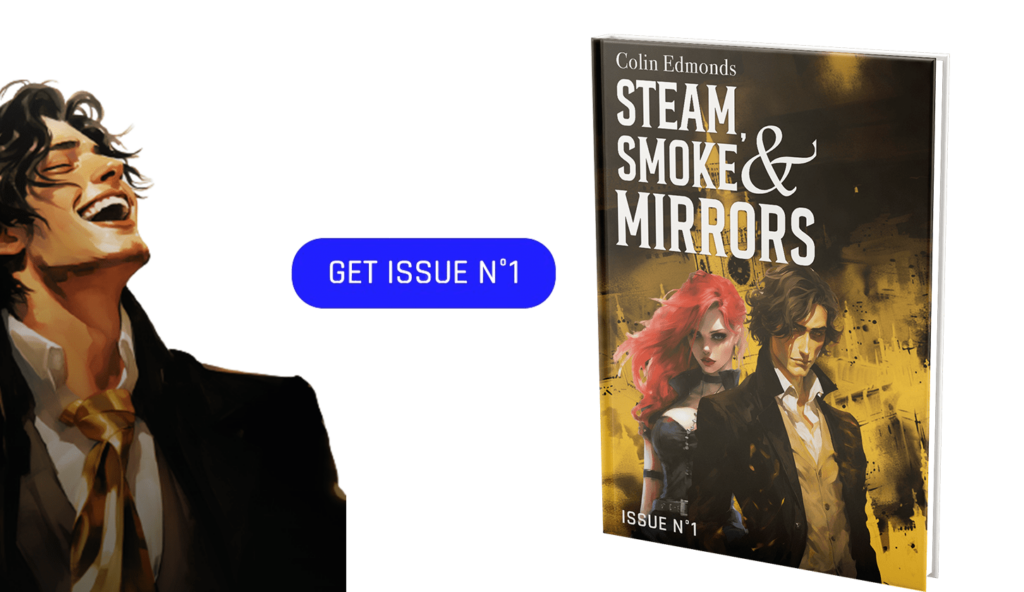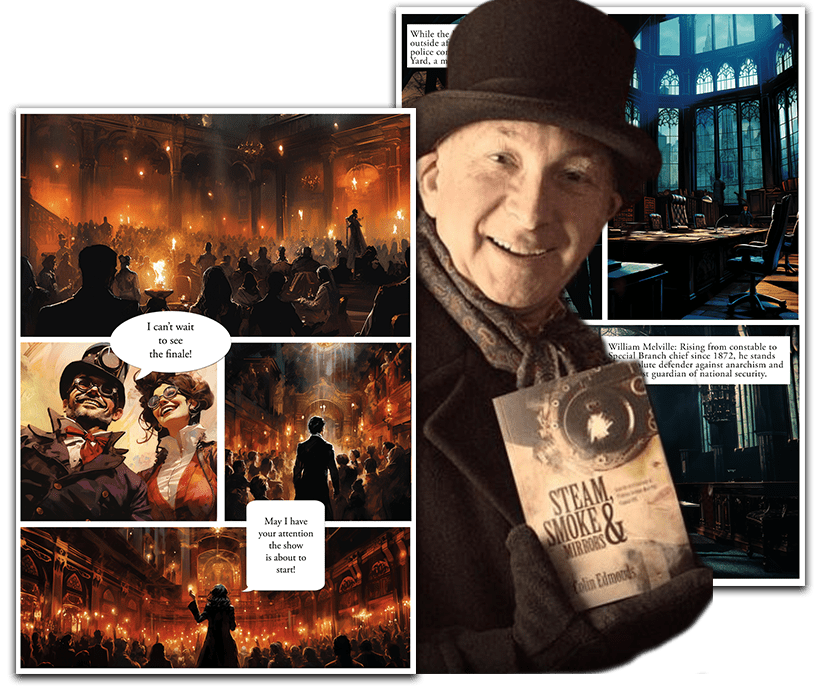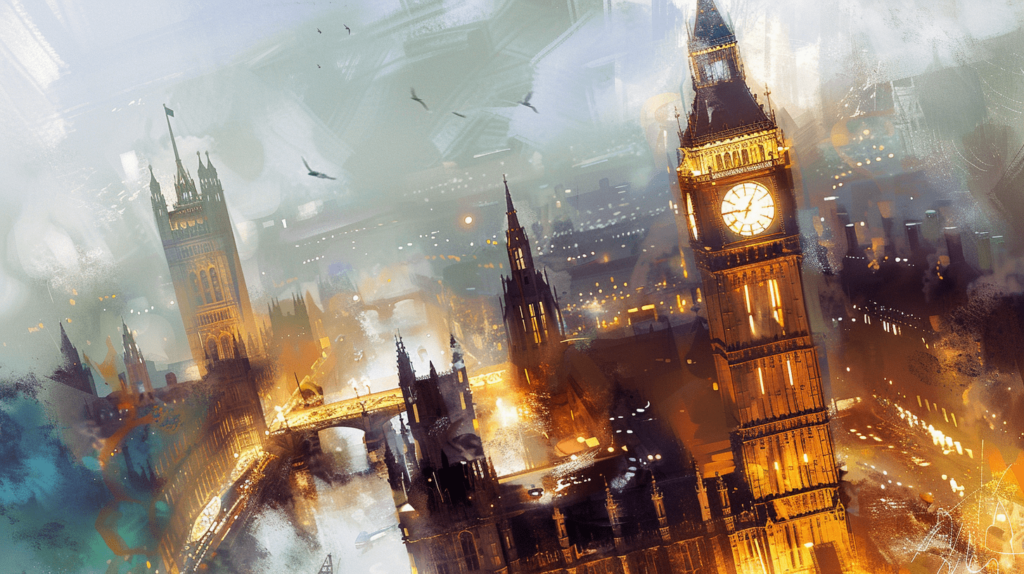Caffeine Publishing Nights and Blukokoro have collaborated to adapt Colin Edmonds’ well-known book, “Steam, Smoke, and Mirrors,” into a graphic novel. The project has taken a hybrid approach, using mixed software to create the graphic novels. Colin Edmonds is a distinguished author, and this adaptation is enthralling. In this interview, we had the chance to gain insight into a publishing company’s perspective on the intersection of AI and literature.
Can you share the journey and the core mission of Caffeine Night Publishing, and how it started?
Caffeine Nights started at the turn of the century and was the extension of an online platform that I started in the 1990s. At that point, I was aware that publishing was a closed shop for people from working class backgrounds. Publishing in the UK was (and sadly still is to a large degree) very class driven with the middle and upper classes having dominion over the industry in terms of not only what is published but by who curates the work, edits it and contributes to the marketing and graphic design of the covers etc. All aspects were a closed world to the large majority of people from poorer backgrounds who actually bought large volumes of books. During the 1990s I was running a writing group, and it was apparent that there was no outlet for some great work from working class authors. With the advent of the internet, I quickly realised that suddenly there was a new platform that would lend itself to these unpublished works and I began to publish stories from writers like me, from an ordinary background with something to say. These were early days of the internet, and I launched a website, 24/7 Caffeine Nights. It feels almost embarrassing now, but I quickly looked at what other options there were, and it soon become apparent that this was indeed a dawn of a new democratic platform that opened up many possibilities for unheard voices. I quickly started exploring eBook platforms years before eBooks become popular. But, from my discussions with authors it was clear they also wanted their work to be published in traditional formats such as paperbacks.

I located a company that was already printing books as print on demand with a digital press and with low volume. This became a relatively affordable model to start with and in 2007 we launched our first paperback novels and changed name to Caffeine Nights Publishing. It was an exciting time as eBooks were finally beginning to take off and the income from this began to help supplement print copies. We quickly took the decision to print all books as well as offer eBooks. By 2014 we had published about 60 titles and eBook sales were phenomenal.
Our authors were also launching in bookstores and libraries, and we were having success with newspaper articles in major daily newspapers. We were always ahead of the curve and during 2014 we developed an app with some great American partners which housed our entire eBook catalogue and eBooks from other publishers. The app was a finalist and close runner up in the Bookseller Awards that year. Our main focus at the time was crime fiction but there was always a love of darker fiction with some books crossing over into the realms of supernatural and horror. It was around this time a literary agent contacted me regarding publishing horror fiction legend, Shaun Hutson. Shaun was second only to James Herbert in the UK in the 1980s and 1990s. This was quite a coup for a small publisher, and we immediately began publishing Shaun’s back catalogue with a firm eye on taking on new works from Shaun. This added horror to our catalogue.
Also 2014, I was contacted by a steampunk author with a great pedigree of television writing, Colin Edmonds. This was a new genre to me, but I loved Colin’s book, Steam, Smoke and Mirrors. So now we had three main genres to work with. We began work on various audiobooks at this time and Steam, Smoke & Mirrors became an award-winning audio title, scooping a SOVAS – the audio equivalent of an Oscar at a gala award ceremony in Los Angeles in 2019. In 2022, we sold the film rights to Shaun Hutson’s horror thriller, ‘Chase’ to an independent film company, Shogun Films. Things have been delayed due to the SAG writer’s strike, but we are looking forward to this going into production in 2024/2025. At the time of writing this we have published over 150 individual titles from around 50 authors. We have won awards, been shortlisted, worked with a film company on novelisations of film titles, had authors appear on TV, radio in major daily newspapers, local newspapers, magazines, virtually every type of media.

In your perspective, what are the key elements that constitute a compelling story?
One of my favourite parts of owning Caffeine Nights Publishing is curating new titles. After having read hundreds of submissions you instantly know when something feels a little special. Sometimes it’s the dynamic of the plot and characterisations. Sometimes it’s the unique atmosphere, occasionally it’s a mixture of all of those elements. For me, what makes a compelling story though is caring about the characters and what happens to them. Even caring about the bad guys, because then you know the writer has made the character fully dimensional. A novel for me has to instantly grab you, either by the dynamism of the plot or the realisation of the characters and setting up what is in store for them. For me, it’s as through the author has picked me up and dropped me in the world they have invented. I’d like to think this is the case with all books we publish. I know it’s the case with the Steam, Smoke & Mirrors series by Colin Edmonds.
How has the advent of Artificial Intelligence impacted the publishing industry, by your point of view?
AI is already having both a positive and negative effect. Let’s look at this in a balanced way as I am an early adopter of new technologies in publishing and always keen to see the benefits. AI can be used in tandem with creatives to produce works that simply would not exist without AI’s help. This can be in a visual sense using platforms like MidJouney and of course excitingly with Blukokoro, which has been a very collaborative experience. As a publisher, I am keen to explore the boundaries but retain creative control. I have used AI generated images as briefing images with our graphic designers who work on our book covers to put across my ideas, which I can’t always verbalise. They then take the AI image and create from this idea. One of the less positive ways might be the infiltration of AI generated fiction and non-fiction by so called authors who don’t have the creative skills to do so. AI non-fiction is already alive and well in Amazon’s charts and I dare say there may be a few fiction novels too. For me the best use of AI is collaborative and requires human input, not sole reliance on the machine. AI can be a positive benefit for the arts but it must always retain a human element.

How crucial do you believe character development is to the overall narrative of a story, and how does Caffeine Night Publishing work with authors to ensure robust character arcs?
Character development is key. It is like a friendship. When you meet someone for the first time you don’t know all about them but over time you learn the good and the bad. That’s how I see character development. I love it when a character you’ve grown to love does something out of character and throws a real curveball. I also like the unreliable narrator as long as it isn’t used as a tactic to cover a badly plotted novel. It has to be genuine. Many authors often mistake character development as description or physicality, but for me character development is like wearing a second skin, caring for a friend or relative and them taking you on a journey where you learn about them and care about them. If something doesn’t sit right and can be worked on, then we offer advice. However, all of the authors we work with seem to have an intrinsic knack of making fully rounded and developed characters whom we believe in and often care for…even the bad guys. Bad guys must be as believable as good guys. The best bad and good guys are grey, not black and white.
In your opinion, what makes a character memorable and relatable to readers, and can you provide an example of a character from one of your publications that embodies these qualities?
I think if the reader cares what happens to a character and feels genuinely emotionally moved, be that through laughter, fear, anger, sadness or one of many emotions then a writer has done his job well. In Colin Edmonds Steam Smoke and Mirrors books, Colin uses humour and then unsettles the reader by the use of some very dramatic and well written scenes, where some key characters meet and unexpected and untimely fate. The juxtaposition of humour and drama often works well in tugging emotions. As a writer, if you yourself are neither entertained nor moved at some level by your writing then there is a 100% chance no one else will be.

How do you perceive the interplay between character development and plot progression, and how does Caffeine Night Publishing ensure a harmonious balance between the two in its publications?
I honestly believe this is the work of the author. If something doesn’t sit correctly in the novel with the reader, we will offer guidance, but our authors are skilled enough to combine character development and plot development. The characters should drive the plot, not the other way round. If a novel is plot heavy and character light, there is very little chance we would progress with it, as the balance would never be corrected without a major rewrite. The reader must engage with the character and the plot.
Some stories are character-driven while others are plot-driven. What is your perspective on the merits of each approach, and does Caffeine Night Publishing have a preference or specialty in one over the other?
My preference is to strike a perfect balance between character and plot. Open the book strong but with rounded characters. A novel has plenty of time for differing the pace and ebb and flow of the story, but the opening is key. Grab the reader quickly, establish the key players, not all of them but certainly some of the main players. Ensure the pace of the plot is a combination of well-paced excitement and leave room for quieter moments to build tension. Building tension is one of the key drivers of plot.
Can you elaborate on the advantages that AI technologies bring to the publishing process, perhaps in terms of manuscript selection, editing, or marketing strategies?
I don’t think we have begun to see the opportunities AI can bring marketing or even working with manuscripts. For smaller publishers and self-publishers, if used intelligently, AI can bring in a much needed third eye, but don’t rely on it, use it as an aid. In terms of marketing for outstretched smaller companies AI can help develop marketing strategies and social posts and bring much needed relief to overworked staff. However, don’t rely on it to be 100% correct. Cast a human eye and mind over anything AI produces. I think manuscript selection must be retained by the human eye and mind. As mentioned, I love the curation part of publishing. To have an AI do that would strip the soul from our business. AI can aid all elements, but it needs to be balanced and used as an aid. Not as a creator.
While AI brings numerous advantages, it also comes with potential risks and challenges. What are some of the ethical considerations and challenges about it?
I think unless addressed we will see what is already happening in the film/movie industry and that is, raising the dead. Ethically this is already challenging the movie industry. Even de-ageing actors is a questionable to a degree. I can see a future where AI, at the bequest of a person, will try to replicate the voice of a dead author in a quest to quell the demand from a dead author’s readership by wanting a new novel in his or her voice. The publishing industry already does this by employing well known authors to write new James Bond books as Ian Fleming has long since died. By having AI do this instead it would lead to all sorts of copyright and royalty issues. One of the other challenges where publishing is concerned is plagiarism. There are already case going through the courts where authors are alleging an infringement of copyright. Due to the nature of the way AI works across the internet this will be an on-going issue. If AI becomes truly sentient this will also present additional challenges. Will it be master or servant? Where we will be in five






